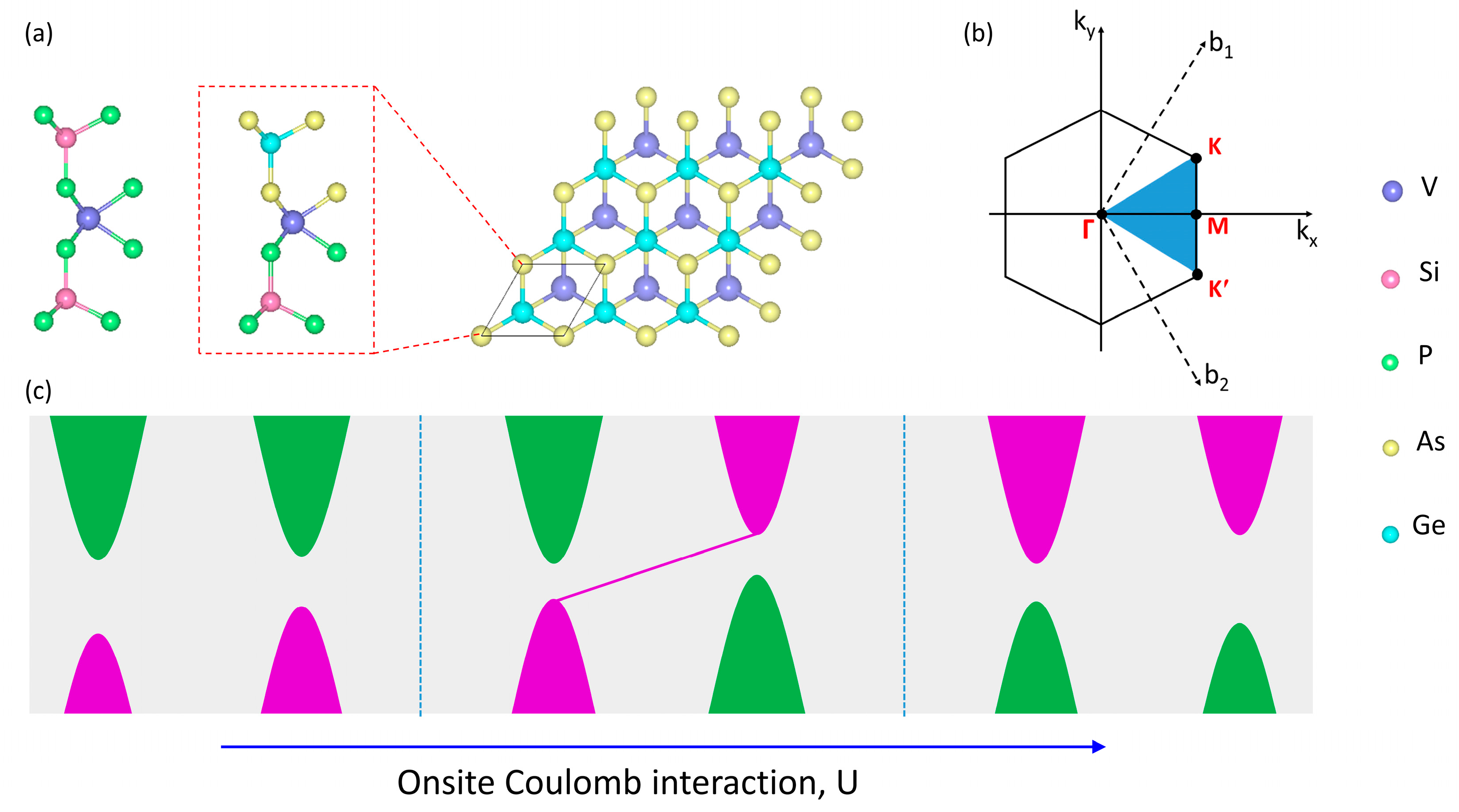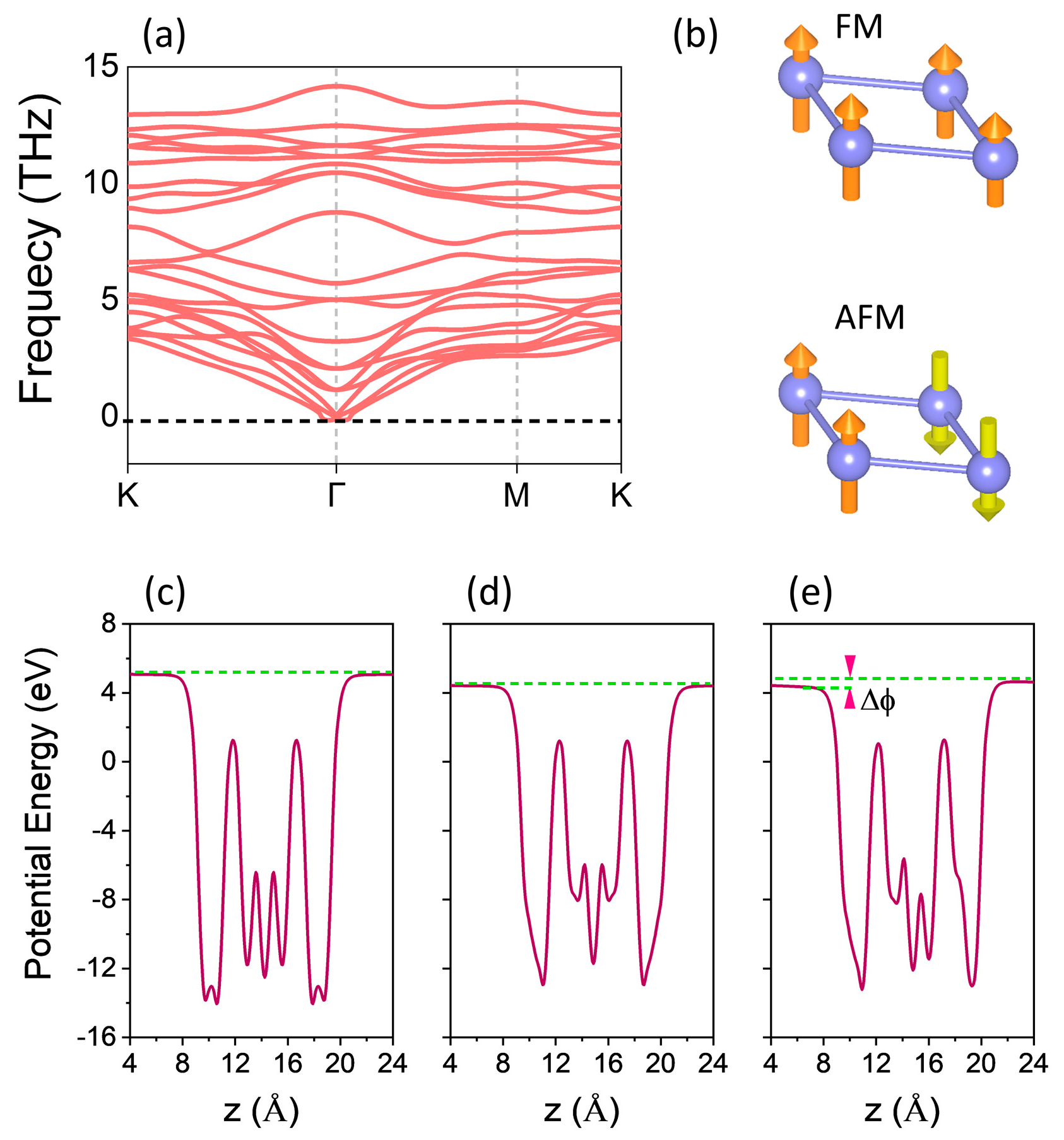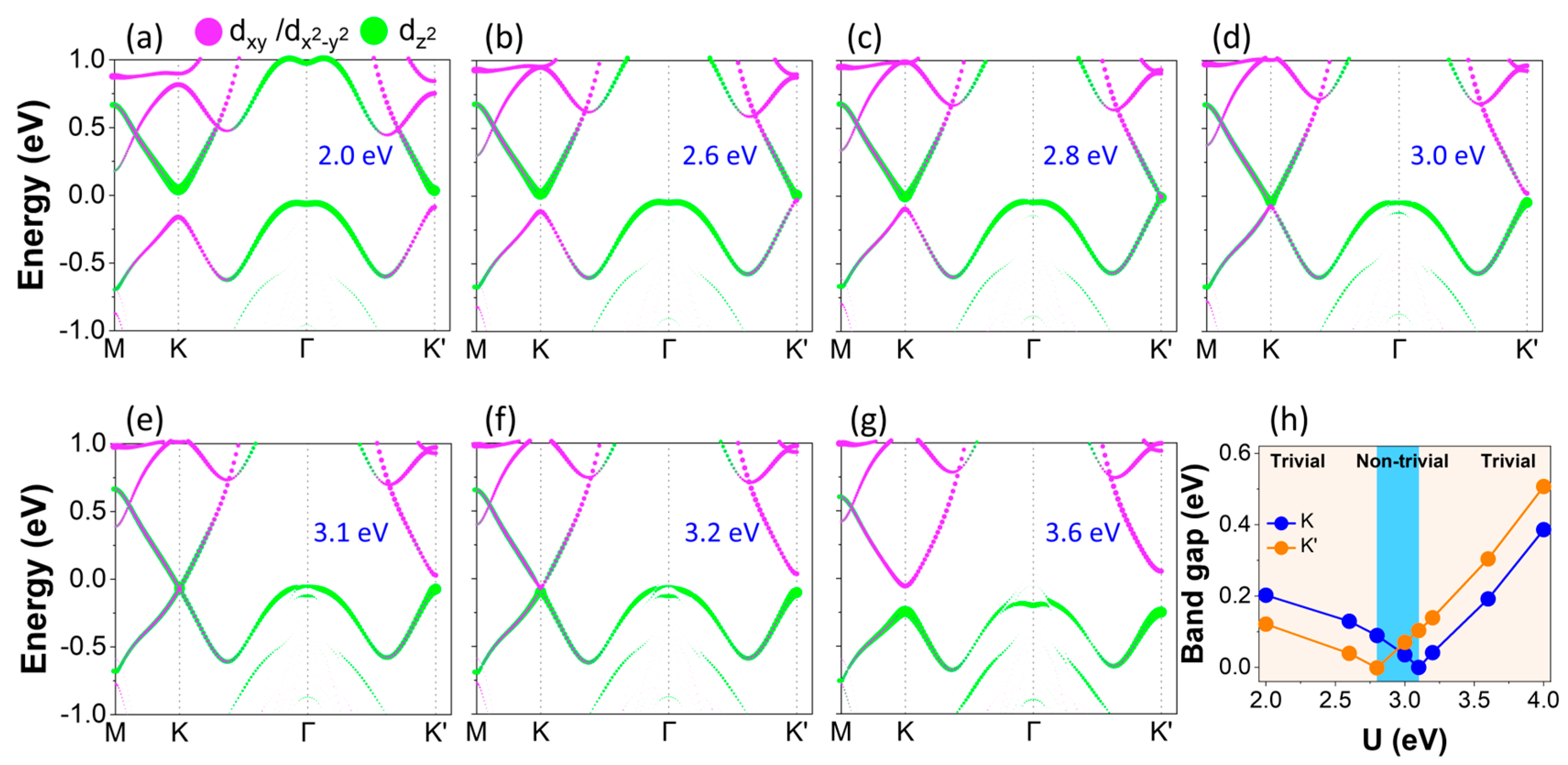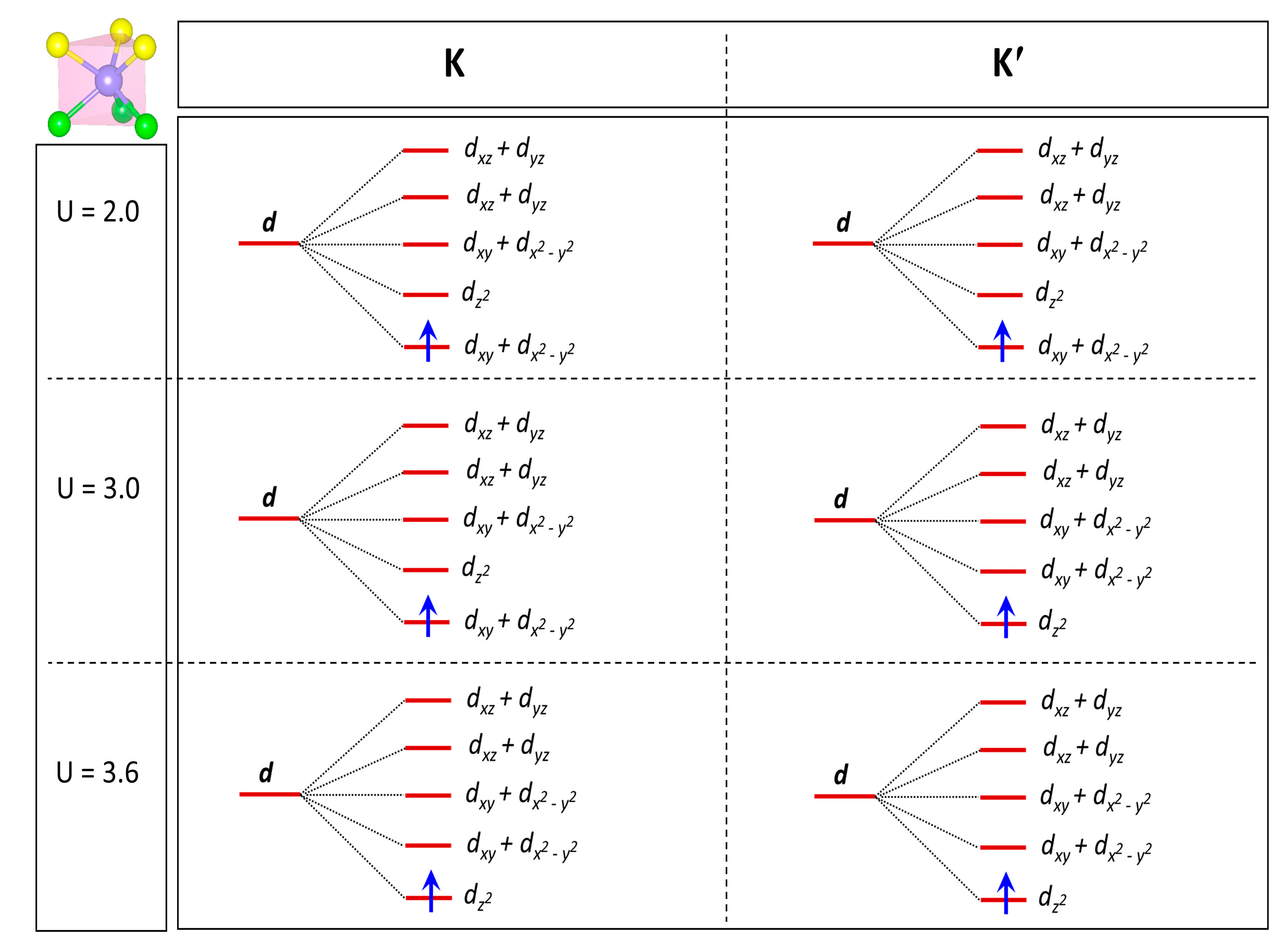Correlation-Driven Topological Transition in Janus Two-Dimensional Vanadates
Abstract
1. Introduction
2. Computational Details
3. Results and Discussion
4. Conclusions
Author Contributions
Funding
Institutional Review Board Statement
Informed Consent Statement
Data Availability Statement
Acknowledgments
Conflicts of Interest
References
- Gong, C.; Li, L.; Li, Z.; Ji, H.; Stern, A.; Xia, Y.; Cao, T.; Bao, W.; Wang, C.; Wang, Y.; et al. Discovery of intrinsic ferromagnetism in two-dimensional van der Waals crystals. Nature 2017, 546, 265–269. [Google Scholar] [CrossRef] [PubMed]
- Huang, B.; Clark, G.; Navarro-Moratalla, E.; Klein, D.R.; Cheng, R.; Seyler, K.L.; Zhong, D.; Schmidgall, E.; McGuire, M.A.; Cobden, D.H.; et al. Layer-dependent ferromagnetism in a van der Waals crystal down to the monolayer limit. Nature 2017, 546, 270–273. [Google Scholar] [CrossRef] [PubMed]
- Li, Y.; Legut, D.; Liu, X.; Lin, C.; Feng, X.; Li, Z.; Zhang, Q. Modulated Ferromagnetism and Electric Polarization Induced by Surface Vacancy in MX2 Monolayers. J. Phys. Chem. C 2022, 126, 8817–8825. [Google Scholar] [CrossRef]
- Tiwari, S.; Vanherck, J.; Van de Put, M.L.; Vandenberghe, W.G.; Sorée, B. Computing Curie temperature of two-dimensional ferromagnets in the presence of exchange anisotropy. Phys. Rev. Res. 2021, 3, 043024. [Google Scholar] [CrossRef]
- Sheng, K.; Zhang, B.; Yuan, H.-K.; Wang, Z.-Y. Strain-engineered topological phase transitions in ferrovalley 2H−RuCl2 monolayer. Phys. Rev. B 2022, 105, 195312. [Google Scholar] [CrossRef]
- Li, C.; An, Y. Tunable magnetocrystalline anisotropy and valley polarization in an intrinsic ferromagnetic Janus 2H-VTeSe monolayer. Phys. Rev. B 2022, 106, 115417. [Google Scholar] [CrossRef]
- Yin, Y.; Gong, Q.; Yi, M.; Guo, W. Emerging versatile two-dimensional MoSi2N4 family. arXiv 2022, arXiv:2211.00827. [Google Scholar]
- Islam, R.; Ghosh, B.; Autieri, C.; Chowdhury, S.; Bansil, A.; Agarwal, A.; Singh, B. Tunable spin polarization and electronic structure of bottom-up synthesized MoSi2N4 materials. Phys. Rev. B 2021, 104, L201112. [Google Scholar] [CrossRef]
- Feng, X.; Xu, X.; He, Z.; Peng, R.; Dai, Y.; Huang, B.; Ma, Y. Valley-related multiple Hall effect in monolayer VSi2P4. Phys. Rev. B 2021, 104, 075421. [Google Scholar] [CrossRef]
- Autieri, C.; Cuono, G.; Noce, C.; Rybak, M.; Kotur, K.M.; Agrapidis, C.E.; Wohlfeld, K.; Birowska, M. Limited Ferromagnetic Interactions in Monolayers of MPS3 (M = Mn and Ni). J. Phys. Chem. C 2022, 126, 6791–6802. [Google Scholar] [CrossRef]
- Basnet, R.; Kotur, K.M.; Rybak, M.; Stephenson, C.; Bishop, S.; Autieri, C.; Birowska, M.; Hu, J. Controlling magnetic exchange and anisotropy by non-magnetic ligand substitution in layered MPX3 (M = Ni, Mn; X = S, Se). Phys. Rev. Res. 2022, 4, 023256. [Google Scholar] [CrossRef]
- Liu, W.; Guo, X.; Schwartz, J.; Xie, H.; Dhale, N.U.; Sung, S.H.; Kondusamy, A.L.N.; Wang, X.; Zhao, H.; Berman, D. A three-stage magnetic phase transition revealed in ultrahigh-quality van der Waals bulk magnet CrSBr. ACS Nano 2022, 16, 15917–15926. [Google Scholar] [CrossRef] [PubMed]
- Liu, X.; Taddei, K.M.; Li, S.; Liu, W.; Dhale, N.; Kadado, R.; Berman, D.; Cruz, C.D.; Lv, B. Canted antiferromagnetism in the quasi-one-dimensional iron chalcogenide BaFe2Se4. Phys. Rev. B 2020, 102, 180403. [Google Scholar] [CrossRef]
- Liu, P.; Liu, S.; Jia, M.; Yin, H.; Zhang, G.; Rena, F.; Wanga, B.; Liu, C. Strain-driven valley states and phase transitions in Janus VSiGeN4 monolayer. Appl. Phys. Lett. 2022, 121, 063103. [Google Scholar] [CrossRef]
- Deng, Y.; Yu, Y.; Song, Y.; Zhang, J.; Wang, N.Z.; Sun, Z.; Yi, Y.; Wu, Y.Z.; Zhu, J. Gate-tunable room-temperature ferromagnetism in two-dimensional Fe3GeTe2. Nature 2018, 563, 94–99. [Google Scholar] [CrossRef] [PubMed]
- Gibertini, M.; Koperski, M.; Morpurgo, A.F.; Novoselov, K.S. Magnetic 2D materials and heterostructures. Nat. Nanotechnol. 2019, 14, 408–419. [Google Scholar] [CrossRef]
- Huang, B.; Clark, G.; Klein, D.; MacNeill, D.; Navarro-Moratalla, E.; Seyler, K.; Wilson, N.; McGuire, M.; Cobden, D.; Xiao, D. Electrical control of 2D magnetism in bilayer CrI3. Nat. Nanotechnol. 2018, 13, 544–548. [Google Scholar] [CrossRef]
- Burch, K.S. Electric switching of magnetism in 2D. Nat. Nanotechnol. 2018, 13, 532. [Google Scholar] [CrossRef]
- Tian, Y.; Gao, W.; Henriksen, E.A.; Chelikowsky, J.R.; Yang, L. Optically driven magnetic phase transition of monolayer RuCl3. Nano Lett. 2019, 19, 7673–7680. [Google Scholar] [CrossRef]
- Zhao, Y.; Lin, L.; Zhou, Q.; Li, Y.; Yuan, S.; Chen, Q.; Dong, S.; Wang, J. Surface vacancy-induced switchable electric polarization and enhanced ferromagnetism in monolayer metal trihalides. Nano Lett. 2018, 18, 2943–2949. [Google Scholar] [CrossRef]
- Song, X.; Yuan, F.; Schoop, L.M. The properties and prospects of chemically exfoliated nanosheets for quantum materials in two dimensions. Appl. Phys. Rev. 2021, 8, 011312. [Google Scholar] [CrossRef]
- Jiang, S.; Xie, H.; Shan, J.; Mak, K.F. Exchange magnetostriction in two-dimensional antiferromagnets. Nat. Mater. 2020, 19, 1295–1299. [Google Scholar] [CrossRef] [PubMed]
- Mermin, N.D.; Wagner, H. Absence of ferromagnetism or antiferromagnetism in one-or two-dimensional isotropic Heisenberg models. Phys. Rev. Lett. 1966, 17, 1133. [Google Scholar] [CrossRef]
- Lado, J.L.; Fernández-Rossier, J. On the origin of magnetic anisotropy in two dimensional CrI3. 2D Mater. 2017, 4, 035002. [Google Scholar] [CrossRef]
- Gurney, B.; Yamada, K.; Nakatani, Y.; Prejbeanu, I.-L.; Diény, B.; Pirro, P.; Hillebrands, B. Spin valve giant magnetoresistive sensor materials for hard disk drives. In Ultrathin Magnetic Structures IV; Springer: Berlin/Heidelberg, Germany, 2005; pp. 149–175. [Google Scholar]
- Prinz, G.A. Magnetoelectronics. Science 1998, 282, 1660–1663. [Google Scholar] [CrossRef]
- Kryder, M.H. Magnetic thin films for data storage. Thin Solid Films 1992, 216, 174–180. [Google Scholar] [CrossRef]
- Webster, L.; Yan, J.-A. Strain-tunable magnetic anisotropy in monolayer CrCl3, CrBr3, and CrI3. Phys. Rev. B 2018, 98, 144411. [Google Scholar] [CrossRef]
- Singla, R.; Hackett, T.A.; Kumar, S.; Sharmad, J.; Kashyap, M.K. Curie temperature engineering in a novel 2D analog of iron ore (hematene) via strain. Nanoscale Adv. 2020, 2, 5890–5896. [Google Scholar] [CrossRef]
- Hussain, G.; Manzoor, M.; Iqbal, M.W.; Muhammad, I.; Bafekry, A.; Ullah, H.; Autieri, C. Strain modulated electronic and optical properties of laterally stitched MoSi2N4/XSi2N4 (X = W, Ti) 2D heterostructures. Phys. E Low-Dimens. Syst. Nanostruct. 2022, 144, 115471. [Google Scholar] [CrossRef]
- Zhang, J.; Wang, Y.; Hua, C.; Yang, S.; Liu, Y.; Luo, J.; Liu, T.; Nai, J.; Tao, X. Prediction of bipolar VSi2As4 and VGe2As4 monolayers with high Curie temperature and strong magnetocrystalline anisotropy. Phys. Rev. B 2022, 106, 235401. [Google Scholar] [CrossRef]
- Hussain, G.; Cuono, G.; Islam, R.; Trajnerowicz, A.; Jureńczyk, J.; Autieri, C.; Dietl, T. Electronic and optical properties of InAs/InAs0.625Sb0.375 superlattices and their application for far-infrared detectors. J. Phys. D Appl. Phys. 2022, 55, 495301. [Google Scholar] [CrossRef]
- Dey, D.; Ray, A.; Yu, L. Intrinsic ferromagnetism and restrictive thermodynamic stability in MA2N4 and Janus VSiGeN4 monolayers. Phys. Rev. Mater. 2022, 6, L061002. [Google Scholar] [CrossRef]
- Hong, Y.-L.; Liu, Z.; Wang, L.; Zhou, T.; Ma, W.; Xu, C.; Feng, S.; Chen, L.; Chen, M.-L.; Sun, D.-M. Chemical vapor deposition of layered two-dimensional MoSi2N4 materials. Science 2020, 369, 670–674. [Google Scholar] [CrossRef] [PubMed]
- Cao, L. Two-dimensional van der Waals electrical contact to monolayer MoSi2N4. Appl. Phys. Lett. 2021, 118, 013106. [Google Scholar] [CrossRef]
- Bafekry, A.; Faraji, M.; Hoat, D.M.; Shahrokhi, M.; Fadlallah, M.M.; Feghhi, S.A.H.; Ghergherehchi, M.; Gogova, D. MoSi2N4 single-layer: A novel two-dimensional material with outstanding mechanical, thermal, electronic and optical properties. J. Phys. D Appl. Phys. 2021, 54, 155303. [Google Scholar] [CrossRef]
- Mortazavi, B.; Javvaji, B.; Shojaei, F.; Rabczuk, T.; Shapeev, A.V.; Zhuang, X. Exceptional piezoelectricity, high thermal conductivity and stiffness and promising photocatalysis in two-dimensional MoSi2N4 family confirmed by first-principles. Nano Energy 2021, 82, 105716. [Google Scholar] [CrossRef]
- Jian, C.-C.; Ma, X.; Zhang, J.; Yong, X. Strained MoSi2N4 monolayers with excellent solar energy absorption and carrier transport properties. J. Phys. Chem. C 2021, 125, 15185–15193. [Google Scholar] [CrossRef]
- Wang, Q.; Cao, L.; Liang, S.-J.; Wu, W.; Wang, G.; Lee, C.H.; Ong, W.L.; Yang, H.Y.; Ang, L.K.; Yang, S.A.; et al. Efficient Ohmic contacts and built-in atomic sublayer protection in MoSi2N4 and WSi2N4 monolayers. npj 2D Mater. Appl. 2021, 5, 71. [Google Scholar] [CrossRef]
- Yu, J.; Zhou, J.; Wan, X.; Li, Q. High intrinsic lattice thermal conductivity in monolayer MoSi2N4. New J. Phys. 2021, 23, 033005. [Google Scholar] [CrossRef]
- Cui, Z.; Luo, Y.; Yu, J.; Xu, Y. Tuning the electronic properties of MoSi2N4 by molecular doping: A first principles investigation. Phys. E Low-Dimens. Syst. Nanostruct. 2021, 134, 114873. [Google Scholar] [CrossRef]
- Bafekry, A.; Faraji, M.; Fadlallah, M.M.; Khatibani, A.B.; Ziabari, A.; Ghergherehchi, M.; Nedaei, S.; Shayesteh, S.F.; Gogova, D. Tunable electronic and magnetic properties of MoSi2N4 monolayer via vacancy defects, atomic adsorption and atomic doping. Appl. Surf. Sci. 2021, 559, 149862. [Google Scholar] [CrossRef]
- Yao, H.; Zhang, C.; Wang, Q.; Li, J.; Yu, Y.; Xu, F.; Wang, B.; Wei, Y. Novel Two-Dimensional Layered MoSi2Z4 (Z = P, As): New Promising Optoelectronic Materials. Nanomaterials 2021, 11, 559. [Google Scholar] [CrossRef] [PubMed]
- Lv, X.; Xu, Y.; Mao, B.; Liu, G.; Zhao, G.; Yang, J. Strain modulation of electronic and optical properties of monolayer MoSi2N4. Phys. E Low-Dimens. Syst. Nanostruct. 2022, 135, 114964. [Google Scholar] [CrossRef]
- Pham, D. Electronic properties of a two-dimensional van der Waals MoGe2N4/MoSi2N4 heterobilayer: Effect of the insertion of a graphene layer and interlayer coupling. RSC Adv. 2021, 11, 28659–28666. [Google Scholar] [CrossRef]
- Yuan, G.; Cheng, Z.; Cheng, Y.; Hui, W.D.; Liu, Z.; Han, C.; Ma, X. Highly Sensitive Band Alignment of Graphene/MoSi2N4 Heterojunction via External Electric Field. ACS Appl. Electron. Mater. 2022, 4, 2897–2905. [Google Scholar] [CrossRef]
- Chen, R.; Chen, D.; Zhang, W. First-principles calculations to investigate stability, electronic and optical properties of fluorinated MoSi2N4 monolayer. Results Phys. 2021, 30, 104864. [Google Scholar] [CrossRef]
- Bafekry, A.; Faraji, M.; Stampfl, C.; Sarsari, A.; Ziabari, A.; Hieu, N.N.; Karbasizadeh, S.; Ghergherehchi, M. Band-gap engineering, magnetic behavior and Dirac-semimetal character in the MoSi2N4 nanoribbon with armchair and zigzag edges. J. Phys. D Appl. Phys. 2021, 55, 035301. [Google Scholar] [CrossRef]
- Ray, A.; Tyagi, S.; Singh, N.; Schwingenschlögl, U. Inducing Half-Metallicity in Monolayer MoSi2N4. ACS Omega 2021, 6, 30371–30375. [Google Scholar] [CrossRef]
- Ng, J.Q.; Wu, Q.; Ang, L.K.; Ang, Y.S. Tunable electronic properties and band alignments of MoSi2N4/GaN and MoSi2N4/ZnO van der Waals heterostructures. Appl. Phys. Lett. 2022, 120, 103101. [Google Scholar] [CrossRef]
- Xu, J.; Wu, Q.; Sun, Z.; Mwankemwa, N.; Zhang, W.-b.; Yang, W.-x. First-principles investigations of electronic, optical, and photocatalytic properties of Au-adsorbed MoSi2N4 monolayer. J. Phys. Chem. Solids 2022, 162, 110494. [Google Scholar] [CrossRef]
- Bafekry, A.; Stampfl, C.; Naseri, M.; Fadlallah, M.M.; Faraji, M.; Ghergherehchi, M.; Gogova, D.; Feghhi, S.A.H. Effect of electric field and vertical strain on the electro-optical properties of the MoSi2N4 bilayer: A first-principles calculation. J. Appl. Phys. 2021, 129, 155103. [Google Scholar] [CrossRef]
- Li, Q.; Zhou, W.; Wan, X.; Zhou, J. Strain effects on monolayer MoSi2N4: Ideal strength and failure mechanism. Phys. E Low-Dimens. Syst. Nanostruct. 2021, 131, 114753. [Google Scholar] [CrossRef]
- Hussain, G.; Asghar, M.; Iqbal, M.W.; Ullah, H.; Autieri, C. Exploring the structural stability, electronic and thermal attributes of synthetic 2D materials and their heterostructures. Appl. Surf. Sci. 2022, 590, 153131. [Google Scholar] [CrossRef]
- Islam, R.; Hussain, G.; Verma, R.; Talezadehlari, M.S.; Muhammad, Z.; Singh, B.; Autieri, C. Fast electrically switchable large gap quantum spin Hall states in MGe2Z4. arXiv 2022, arXiv:2211.06443. [Google Scholar]
- Sheoran, S.; Monga, S.; Phutela, A.; Bhattacharya, S. Coupled Spin-Valley, Rashba Effect, and Hidden Spin Polarization in WSi2N4 Family. J. Phys. Chem. Lett. 2023, 14, 1494–1503. [Google Scholar] [CrossRef]
- Islam, R.; Verma, R.; Ghosh, B.; Muhammad, Z.; Bansil, A.; Autieri, C.; Singh, B. Switchable large-gap quantum spin Hall state in the two-dimensional MSi2Z4 class of materials. Phys. Rev. B 2022, 106, 245149. [Google Scholar] [CrossRef]
- Van Thiel, T.; Brzezicki, W.; Autieri, C.; Hortensius, R.; Afanasiev, D.; Gauquelin, N.; Jannis, D.; Janssen, N.; Groenendijk, J.; Fatermans, J.; et al. Coupling charge and topological reconstructions at polar oxide interfaces. Phys. Rev. Lett. 2021, 127, 127202. [Google Scholar] [CrossRef]
- Smaili, I.; Laref, S.; Garcia, J.H.; Schwingenschlögl, U.; Roche, S.; Manchon, A. Janus monolayers of magnetic transition metal dichalcogenides as an all-in-one platform for spin-orbit torque. Phys. Rev. B 2021, 104, 104415. [Google Scholar] [CrossRef]
- Zhao, X.; Wang, Z.; Chen, J.; Wang, B. Topological properties of Xene turned by perpendicular electric field and exchange field in the presence of Rashba spin-orbit coupling. J. Phys. Condens. Matter 2022, 35, 095401. [Google Scholar] [CrossRef]
- Hussain, G.; Samad, A.; Rehman, M.U.; Cuono, G.; Autieri, C. Emergence of Rashba splitting and spin-valley properties in Janus MoGeSiP2As2 and WGeSiP2As2 monolayers. J. Magn. Magn. Mater. 2022, 563, 169897. [Google Scholar] [CrossRef]
- Dou, K.; Du, W.; He, Z.; Dai, Y.; Huang, B.; Ma, Y. Theoretical Prediction of Antiferromagnetic Skyrmion Crystal in Janus Monolayer CrSi2N2As2. ACS Nano 2023, 17, 1144–1152. [Google Scholar] [CrossRef] [PubMed]
- Laref, S.; Goli, V.M.L.D.P.; Smaili, I.; Schwingenschlögl, U.; Manchon, A. Topologically stable bimerons and skyrmions in vanadium dichalcogenide Janus monolayers. arXiv 2020, arXiv:2011.07813. [Google Scholar]
- Kresse, G.; Joubert, D. From ultrasoft pseudopotentials to the projector augmented-wave method. Phys. Rev. B 1999, 59, 1758. [Google Scholar] [CrossRef]
- Kresse, G.; Furthmüller, J. Efficient iterative schemes for ab initio total-energy calculations using a plane-wave basis set. Phys. Rev. B 1996, 54, 11169. [Google Scholar] [CrossRef] [PubMed]
- Perdew, J.P.; Burke, K.; Ernzerhof, M. Generalized gradient approximation made simple. Phys. Rev. Lett. 1996, 77, 3865. [Google Scholar] [CrossRef] [PubMed]
- Togo, A.; Tanaka, I. First principles phonon calculations in materials science. Scr. Mater. 2015, 108, 1–5. [Google Scholar] [CrossRef]
- Cuono, G.; Autieri, C.; Guarnaccia, G.; Avella, A.; Cuoco, M.; Forte, F.; Noce, C. Spin–orbit coupling effects on the electronic properties of the pressure-induced superconductor CrAs. Eur. Phys. J. Spec. Top. 2019, 228, 631–641. [Google Scholar] [CrossRef]
- Wadge, A.S.; Grabecki, G.; Autieri, C.; Kowalski, B.J.; Iwanowski, P.; Cuono, G.; Islam, M.F.; Canali, C.M.; Dybko, K.; Hruban, A.; et al. Electronic properties of TaAs2 topological semimetal investigated by transport and ARPES. J. Phys. Condens. Matter 2022, 34, 125601. [Google Scholar] [CrossRef]
- Li, F.; Wei, W.; Zhao, P.; Huang, B.; Dai, Y. Electronic and optical properties of pristine and vertical and lateral heterostructures of Janus MoSSe and WSSe. J. Phys. Chem. Lett. 2017, 8, 5959–5965. [Google Scholar] [CrossRef]
- Yan, S.; Qiao, W.; He, X.; Guo, X.; Xi, L.; Zhong, W.; Du, Y. Enhancement of magnetism by structural phase transition in MoS2. Appl. Phys. Lett. 2015, 106, 012408. [Google Scholar] [CrossRef]
- Ominato, Y.; Fujimoto, J.; Matsuo, M. Valley-dependent spin transport in monolayer transition-metal dichalcogenides. Phys. Rev. Lett. 2020, 124, 166803. [Google Scholar] [CrossRef] [PubMed]
- Ahammed, R.; De Sarkar, A. Valley spin polarization in two-dimensional h−MN (M = Nb, Ta) monolayers: Merger of valleytronics with spintronics. Phys. Rev. B 2022, 105, 045426. [Google Scholar] [CrossRef]
- Cui, Q.; Zhu, Y.; Liang, J.; Cui, P.; Yang, H. Spin-valley coupling in a two-dimensional VSi2N4 monolayer. Phys. Rev. B 2021, 103, 085421. [Google Scholar] [CrossRef]







| Material | ao (Å) | [EFM − EAFM] (eV) | Easy Axis |
| VSi2P4 | 3.448 | −0.143 | Out-of-plane |
| VSi2As4 | 3.592 | −0.202 | In-plane |
| VSiGeP2As2 | 3.562 | −0.210 | In-plane |
Disclaimer/Publisher’s Note: The statements, opinions and data contained in all publications are solely those of the individual author(s) and contributor(s) and not of MDPI and/or the editor(s). MDPI and/or the editor(s) disclaim responsibility for any injury to people or property resulting from any ideas, methods, instructions or products referred to in the content. |
© 2023 by the authors. Licensee MDPI, Basel, Switzerland. This article is an open access article distributed under the terms and conditions of the Creative Commons Attribution (CC BY) license (https://creativecommons.org/licenses/by/4.0/).
Share and Cite
Hussain, G.; Fakhredine, A.; Islam, R.; Sattigeri, R.M.; Autieri, C.; Cuono, G. Correlation-Driven Topological Transition in Janus Two-Dimensional Vanadates. Materials 2023, 16, 1649. https://doi.org/10.3390/ma16041649
Hussain G, Fakhredine A, Islam R, Sattigeri RM, Autieri C, Cuono G. Correlation-Driven Topological Transition in Janus Two-Dimensional Vanadates. Materials. 2023; 16(4):1649. https://doi.org/10.3390/ma16041649
Chicago/Turabian StyleHussain, Ghulam, Amar Fakhredine, Rajibul Islam, Raghottam M. Sattigeri, Carmine Autieri, and Giuseppe Cuono. 2023. "Correlation-Driven Topological Transition in Janus Two-Dimensional Vanadates" Materials 16, no. 4: 1649. https://doi.org/10.3390/ma16041649
APA StyleHussain, G., Fakhredine, A., Islam, R., Sattigeri, R. M., Autieri, C., & Cuono, G. (2023). Correlation-Driven Topological Transition in Janus Two-Dimensional Vanadates. Materials, 16(4), 1649. https://doi.org/10.3390/ma16041649






